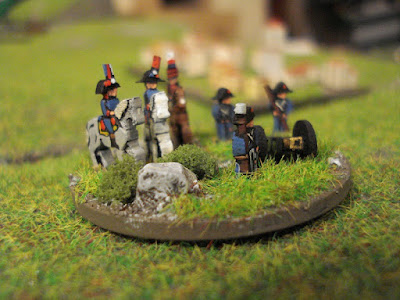 |
| Napoleon at the Battle of Rivoli, by Philippoteaux (Galerie des Batailles, Palace of Versailles) |
For the last couple of years I've been working on a project of recreating the Battle of Rivoli, 14 January 1797. The aim was to do this in 6mm MDF miniatures bought from Commission Figurines, using Volley and Bayonet rules to replicate army level decision making.
Brief Information about the Battle of Rivoli
In short, the French under General Bonaparte had pushed the Austrians east out of Lombardy and back onto Tyrol. A substantial Austrian army was besieged in the city of Mantua. During the summer and autumn months of 1796, the Austrians had attempted to lift the siege and free Mantua... without success. This was yet another attempt under the Imperial General Alvinczy. Bonaparte, realizing what the Austrian plan was, decided to defend at Rivoli where Joubert's division was deployed and to send Massena's division to reinforce.
You can get a more detailed brief here.
With all the figures now painted and the scenery coming together, I thought it was time to do a rough set up and see how the game looked and played.
I knew that I wanted to keep an eye on the process because I would probably want to adapt the rules slightly to better fit warfare during the Revolutionary Wars. But, I also wanted to see if the strength and morale ratings that I had given the various units worked and provided both sides with the chance to win. So with notebook handy in order to jot down thoughts for changes, I played the game through.
The photos will show that I did not set up a finished table, as the unkempt felt bits for woods will reveal.
 |
| The starting positions of the Austrians just as they are about to attack the French positions on the Trombalore Heights on the right. |
 |
| The battlefield as seen from the south looking north. The eastern edge of the table showing the river Adige and the Adige valley/ravine. |
 |
| A close up of the army command stand. Simple paint work on these charming MDF figures. There is a surprising amount of detail (belts etc.) burnt onto the figures. |
 |
| The Austrian assault on the French positions. |
 |
| Looking from east to west. The heights remain contested, though the French prepare for a counter-attack. The Austrian divisions are becoming exhausted. |
 |
| Austrian artillery arrived on the other side of the Adige. However, I called it a day at this point as I could see no way for the Austrians to win and I'd seen enough to draw some conclusions. |
3. Each unit is given a number of hits (strength points) it can take before destroyed. This is usually linked to the number in the unit, normally 1 strength point per 500 men. This led to some units having only 1 or 2 strength points, and therefore easily dispatched. For game purposes I believe that I need to make this a minimum of 3 points per infantry unit.







Sounds like a very interesting battle. And I love what you have done with those MDF flats. They are really excellent and your (very precise) painting brings them to life. On the table you really can't tell the difference between them and regular 6mm figures.
ReplyDeleteThank you Lee. I can't want to get the rules and terrain finished so that I can put this game on for the Rejects.
DeleteLooking good Richard. I can't wait to have a game with these great looking figures!
ReplyDeleteThanks Ray, my own levels of anticipation are rising too.
DeleteVery enjoyable - thanks.
ReplyDeleteGlad you liked it Norm.
DeleteGlad you liked it Norm.
DeleteReally interesting sir!
ReplyDeleteBest
Thanks Michal. I try my best.
DeleteHopefully you can do a real game soon.
ReplyDeleteHeard so much about you and seen so many pictures on Ray's blog, feel like I know you. Welcome to the blogging world.
Ah yes, Ray is a good publicist. Thank you for the welcome Alex.
DeleteGreat looking game on a nice table sir. For mdf and at such a small scale I'm impressed very much with those sculpts.
ReplyDeleteThanks Dai. I was impressed at how much detail was burnt into them.
DeleteI recognise most of the aspects of your layout having participated in Jonathan Freitag's of the Palouse Wargaming Journal's remote game a year or so ago, and can vouch that it was hugely enjoyable.
ReplyDeleteThank for the plug, Lawrence! That was a fun battle, wasn't it?
DeleteCheers Lawrence. It's nice to know that it at least looks the part.
DeleteNot seen little msg before, really nice. I do love Volley and Bayonet, still playing the original version after 30 years.
ReplyDeleteI'm with you in using the original version. Just goes to show that quality stands the test of time.
DeleteRichard, your Rivoli battle is shaping up nicely. Having fought this action more than once, I look forward to following your refight with great interest.
ReplyDeleteMy last fight of this battle was a multi-player remote game last about two months. My summary of this action can be found at:
https://palousewargamingjournal.blogspot.com/2021/03/rivoli-executive-summary-of-battle.html.
Thanks for the kind words Jonathan. I'll head over and have a look as soon as possible.
Delete